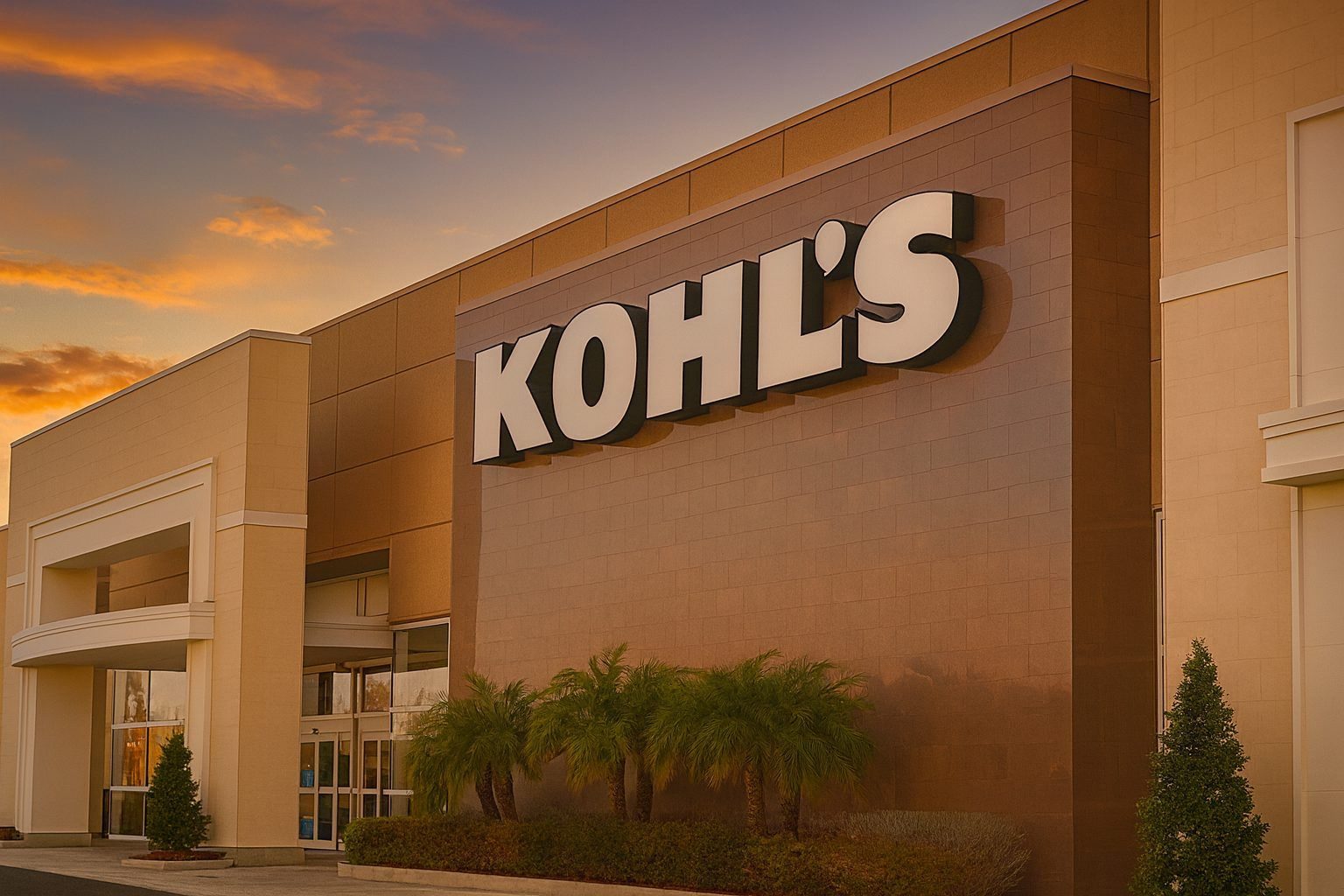Kohl’s Corporation (NYSE: KSS) heads into a high‑stakes trading day on Tuesday, November 25, 2025, with a fresh CEO, an earnings report due, and the holiday shopping season ramping up—all against a backdrop of heavy short interest and lingering doubts about the department‑store model.
As of early Tuesday, KSS is trading around $15.70 per share, giving Kohl’s a market value of roughly $1.8 billion and leaving the stock in the lower half of its 52‑week range of about $6.04 to $21.39. [1]
Key Takeaways for KSS Stock on November 25, 2025
- Share price: Around the mid‑$15s, modestly above where it started the year but far below its summer highs near $21. [2]
- New leadership: Interim chief Michael J. Bender has been confirmed as permanent CEO, making him Kohl’s fourth CEO since 2018. [3]
- Earnings catalyst: Kohl’s is scheduled to report fiscal third‑quarter results today before the market opens, with Wall Street expecting a modest loss and continued sales decline. [4]
- Dividend: The board recently declared another quarterly dividend of $0.125 per share, payable December 24, 2025, implying a forward yield of just over 3% at current prices. [5]
- Sentiment: Short interest remains elevated at roughly 26–27% of the float, and options markets are pricing in a double‑digit percentage move around earnings. [6]
KSS Stock Price Today: Volatile but Off the Lows
Most real‑time quote services show Kohl’s stock changing hands around $15–$16 on Tuesday morning, up slightly from recent levels but still well below its 52‑week high of $21.39, reached during a meme‑like spike in July. [7]
Barron’s recently noted that despite 2025’s recovery bounce—shares are up about 13% year to date—KSS is still down roughly 14% over the past 12 months, underscoring how deep the longer‑term drawdown has been. [8]
From a valuation angle, Kohl’s trades at a single‑digit trailing price‑to‑earnings ratio around 9–10, based on trailing EPS of roughly $1.5–1.8, which screens as cheap versus the broader retail group—but with good reason given persistent revenue declines and strategic uncertainty. [9]
New CEO Michael Bender Takes the Helm
One of the biggest KSS stock stories today is leadership.
- On November 24, 2025, Kohl’s board officially promoted Michael J. Bender from interim to permanent CEO, effective November 23. [10]
- Bender is a 30‑year retail veteran, with senior roles at Walmart, PepsiCo and optical chain Eyemart Express, and has served on Kohl’s board since 2019. [11]
- He took over as interim CEO in May 2025 after the ouster of Ashley Buchanan, who was removed following an internal investigation into a vendor relationship that violated ethics policies. [12]
AP, Barron’s and other outlets report that the board credited Bender with improving financial performance and corporate culture during his interim tenure, including a stronger‑than‑expected second quarter and a modestly raised full‑year outlook. [13]
At the same time, Kohl’s still faces:
- 14 consecutive quarters of same‑store sales declines as of Q2,
- Years of strategy misfires and revolving‑door leadership,
- Investor fatigue after multiple failed turnaround and sale processes. [14]
For KSS shareholders, today’s earnings call will be the first real chance to hear Bender’s long‑term roadmap—beyond cost cuts and incremental merchandising tweaks.
Earnings Preview: What Wall Street Expects from Kohl’s Today
Kohl’s is scheduled to report fiscal third‑quarter results on Tuesday, November 25, 2025, before the opening bell, with a conference call later in the day. [15]
Across data providers, expectations cluster around:
- EPS: Adjusted loss of about $0.16–$0.17 per share,
- Revenue: Around $3.3–$3.37 billion,
- Same‑store sales (comps): Decline of roughly 3–4% year‑over‑year. [16]
Analyst commentary heading into the print emphasises:
- Top‑line pressure as mid‑income shoppers trade down or delay discretionary purchases,
- Margin resilience thanks to tighter inventories and fewer clearance markdowns,
- The risk that higher‑margin credit revenue and private‑label credit portfolios are peaking. [17]
Historically, Kohl’s has often beaten EPS expectations, helped by cost‑cutting and lower tax or interest expense, even as revenue trends underwhelm. Over the past two years, it has topped EPS estimates about 75% of the time and revenue expectations roughly 60% of the time. [18]
For KSS stock today, the market is likely to focus less on whether EPS beats by a few cents and more on:
- Updated full‑year 2025 guidance—does management stick with or walk back its Q2 outlook of a 5–6% sales decline and adjusted EPS of $0.50–$0.80? [19]
- Holiday commentary—are early trends around Black Friday and Cyber Week in line with expectations? [20]
- Traffic vs. ticket—whether modest comp declines are driven by fewer shoppers, smaller baskets, or both. [21]
How Kohl’s Has Been Performing in 2025 So Far
Despite all the drama, 2025 hasn’t been a total washout for Kohl’s fundamentals.
First Quarter 2025
For the quarter ended May 3, 2025, Kohl’s reported: [22]
- Total revenue: $3.23 billion, down about 4% year‑over‑year,
- Net loss:$15 million, or –$0.13 per share, an improvement from a $27 million loss the prior year,
- Gross margin: 39.9%, up about 40 basis points,
- Continued pressure on SG&A as a share of sales, despite lower absolute expenses.
Second Quarter 2025
For Q2 (ended August 2, 2025), Kohl’s delivered a more encouraging—but still mixed—report: [23]
- Net sales: $3.35 billion, down 5.1% year‑over‑year;
- Comparable sales: down 4.2%;
- Gross margin: 39.9%, up 28 basis points;
- GAAP EPS:$1.35, boosted by a one‑time $129 million legal settlement related to credit‑card interchange fees;
- Adjusted EPS:$0.56, comfortably ahead of analyst forecasts around $0.30–$0.35.
Management used Q2’s beat to raise full‑year guidance, now calling for: [24]
- 2025 net sales down 5–6%,
- Adjusted operating margin of 2.5–2.7%,
- Adjusted diluted EPS in a range of $0.50–$0.80.
The market liked that combination of better margins plus a tighter inventory position; KSS surged more than 20% on the day of the Q2 release, helped by renewed attention from retail traders. [25]
Today’s Q3 report will show whether that progress is sustainable—or just a brief upturn in a longer downtrend.
Dividend, Debt and Balance‑Sheet Picture
Dividend
On November 12, 2025, Kohl’s board declared another quarterly dividend of $0.125 per share, payable December 24 to shareholders of record on December 10. [26]
At the current share price in the mid‑$15s, that equates to a:
- Forward annualized dividend of about $0.50 per share,
- Forward yield in the 3–3.5% range. [27]
That’s less than half the double‑digit yield KSS briefly sported after its 2024 dividend cut, but still meaningful in a beaten‑down retail name.
Debt & Leverage
Kohl’s carries substantial debt and lease obligations, which is a key part of the KSS stock debate.
- By Q1 2025, total assets stood around $13.6 billion, with long‑term debt of roughly $1.17 billion and significant lease liabilities. [28]
- In Q2, Kohl’s repaid $353 million of notes maturing in July 2025 but also issued $360 million of 10% senior secured notes due 2030, lifting long‑term debt to about $1.52 billion. [29]
Credit and leverage trackers note that Kohl’s leverage ratio has improved somewhat thanks to liability repayments, but the company still operates with elevated debt relative to its shrinking sales base. [30]
For equity investors, that means less room for error if the turnaround stalls.
Holiday 2025: Kohl’s Biggest Near‑Term Test
The timing of today’s earnings is no accident: it lands squarely between early Black Friday promotions and the heart of the holiday shopping season.
Kohl’s has spent the fall touting a holiday strategy built around value and convenience, highlighting:
- Curated gift guides and price‑based gifting collections,
- A broadened mix of only‑at‑Kohl’s brands (like LC Lauren Conrad and FLX) alongside big national names such as Nike and Levi’s,
- Extended return windows for most purchases made in October, generally allowing returns through January 31, 2026, with separate terms for Sephora shop‑in‑shop purchases. [31]
The company is also pitching early‑bird Black Friday deals and emphasizing that stores remain closed on Thanksgiving Day, a stance it has held for several years. [32]
For KSS stock, investors will be listening closely for:
- How November traffic and online demand are trending vs. last year,
- Whether shoppers are trading down within the store (cheaper brands, smaller baskets),
- Any signs Kohl’s is gaining—or losing—share in key categories like activewear, beauty (including Sephora at Kohl’s), and home. [33]
Sentiment Check: High Short Interest and Mixed Analyst Views
Heavy Short Interest
Short sellers remain very active in KSS:
- As of October 31, 2025, short interest stood at about 29.3 million shares,
- That’s roughly 26–27% of the public float,
- With a short‑interest ratio of around 7–8 days to cover, based on recent trading volumes. [34]
That’s a huge bearish bet by market standards. It also means that any upside surprise in today’s earnings or guidance could spark a short‑covering rally, especially with options markets pricing elevated implied volatility.
Barchart data shows implied volatility above 90% and an expected near‑term stock move of roughly ±11%, with a short‑dated expected range of about $14.13 to $17.65. [35]
Kohl’s already experienced a meme‑style spike in July, when retail traders piled into the shares, briefly doubling the stock price before it settled back down. [36]
Analyst Ratings & Price Targets
Analysts remain cautious:
- According to MarketBeat, 18 analysts covering KSS have an average 12‑month price target around $12.75, with estimates ranging from $4.50 to $25.00 per share. [37]
- That average target sits below the current share price, implying modest downside from today’s levels if the consensus view proves accurate. [38]
Some research outlets frame Kohl’s as a potential deep‑value or real‑estate play—arguing that its property portfolio may be worth more than the stock’s current market cap—while others warn that the business risks becoming a long‑term “value trap” if traffic and comps keep eroding. [39]
What to Watch on the KSS Earnings Call Today
For traders and longer‑term investors following KSS stock on November 25, these will likely be the headline questions:
- Guidance for Q4 and full‑year 2025
- Does management maintain the improved outlook issued after Q2, or does a softer consumer backdrop force another reset? [40]
- Same‑store sales momentum
- Are comps stabilizing closer to flat, or are declines still in the mid‑single digits?
- How are Sephora shop‑in‑shops and newer categories like FLX performing relative to legacy apparel and footwear? [41]
- Margin sustainability
- Can Kohl’s maintain higher gross margins without over‑promoting during the holidays?
- Are SG&A cuts and store efficiencies offsetting wage and occupancy pressures? [42]
- Balance‑sheet and capital allocation
- Any updates on debt reduction plans or potential real‑estate monetization?
- Is the current dividend level sustainable if comps remain negative? [43]
- Strategic direction from the new CEO
- Does Bender outline tangible initiatives beyond “improve the assortment and experience”—for example, more store closures, more remodels, or partnerships beyond Sephora? [44]
How credibly management answers those questions may matter as much as the headline EPS number for where KSS trades into year‑end.
Bottom Line: A Make‑or‑Break Day for the KSS Turnaround Narrative
On November 25, 2025, Kohl’s sits at a crossroads:
- The stock is cheap on traditional multiples,
- The dividend has been reset to a more modest—arguably sustainable—level,
- A new CEO with solid retail credentials is now officially in charge,
- But the company still faces declining sales, high leverage, and intense competition, all while carrying one of the highest short‑interest levels in U.S. retail. [45]
For KSS stock today, the market’s verdict will hinge on whether Kohl’s can convince investors that holiday 2025 marks the start of a durable stabilization—or just another brief rally in a long, grinding turnaround.
This article is for informational and educational purposes only and does not constitute financial, investment, or trading advice. Always do your own research or consult a qualified financial professional before making investment decisions.
References
1. www.gurufocus.com, 2. www.gurufocus.com, 3. apnews.com, 4. www.nasdaq.com, 5. www.businesswire.com, 6. www.marketbeat.com, 7. www.gurufocus.com, 8. www.barrons.com, 9. www.barchart.com, 10. www.businesswire.com, 11. apnews.com, 12. www.barrons.com, 13. apnews.com, 14. www.barrons.com, 15. www.nasdaq.com, 16. www.marketbeat.com, 17. www.investopedia.com, 18. www.gurufocus.com, 19. www.businesswire.com, 20. investors.kohls.com, 21. www.businesswire.com, 22. www.businesswire.com, 23. investors.kohls.com, 24. www.businesswire.com, 25. www.investopedia.com, 26. www.businesswire.com, 27. finance.yahoo.com, 28. www.businesswire.com, 29. www.businesswire.com, 30. csimarket.com, 31. www.nasdaq.com, 32. investors.kohls.com, 33. news.alphastreet.com, 34. www.marketbeat.com, 35. www.barchart.com, 36. www.reuters.com, 37. www.marketbeat.com, 38. www.marketbeat.com, 39. fintel.io, 40. www.businesswire.com, 41. news.alphastreet.com, 42. www.businesswire.com, 43. www.businesswire.com, 44. apnews.com, 45. www.businesswire.com







